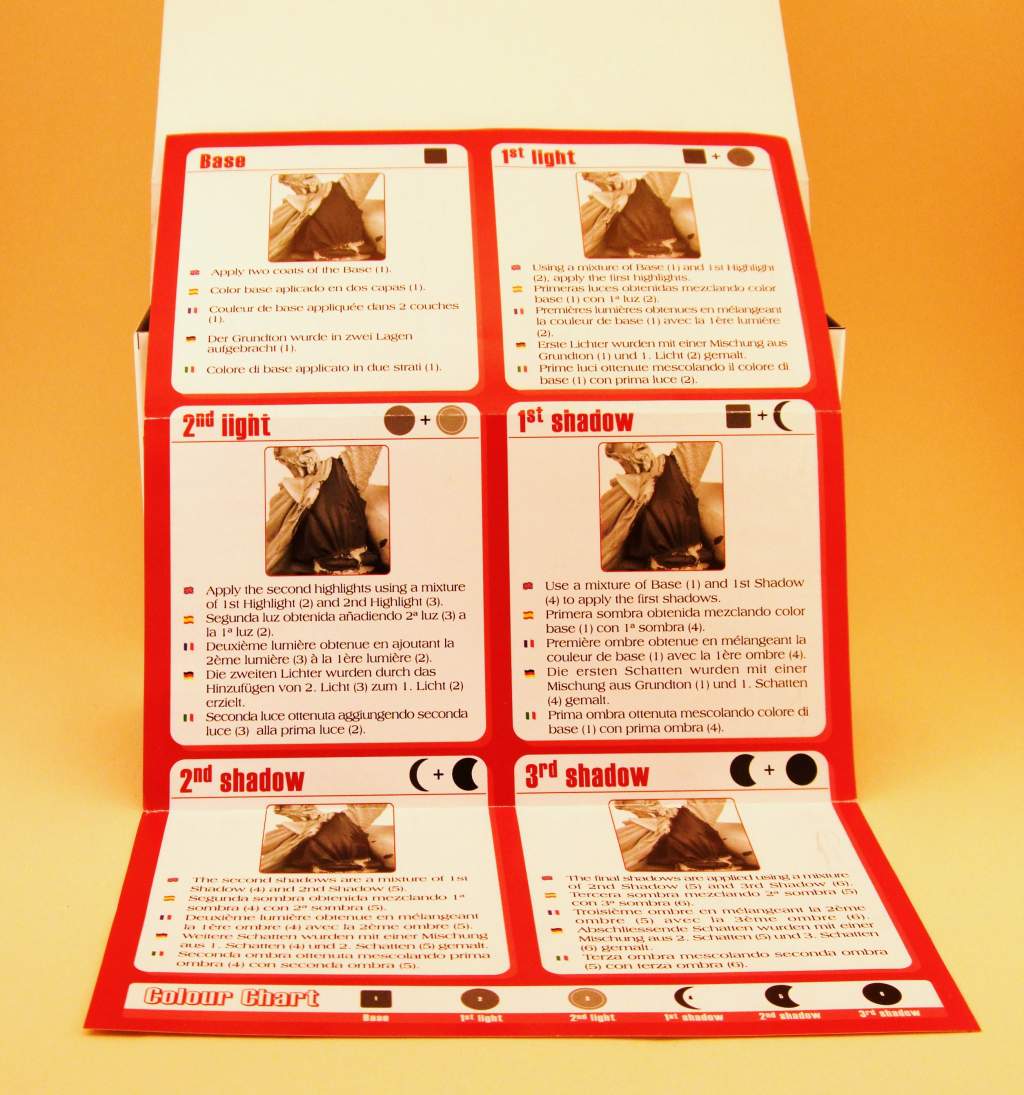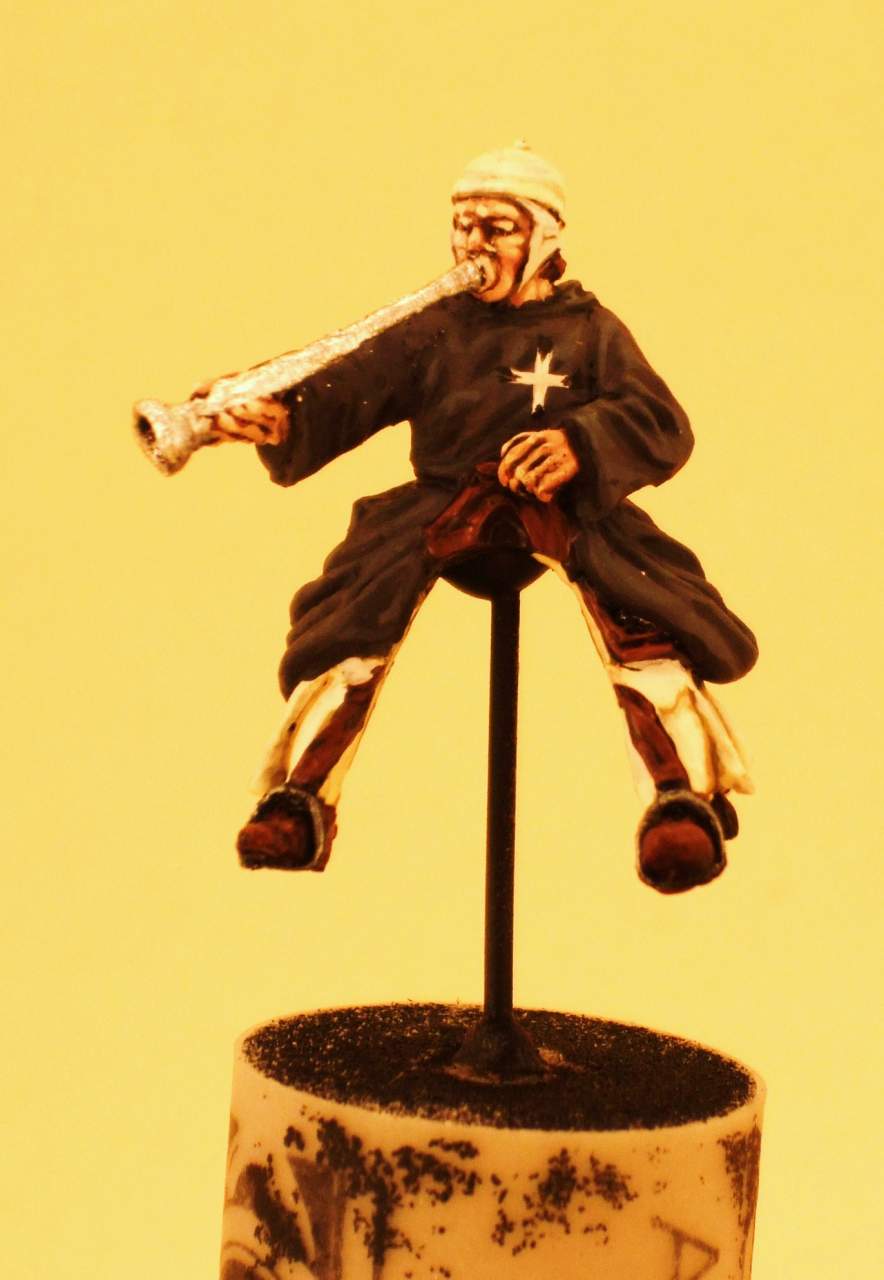Well, I 've gone ahead an purchased m'self a paint kit, which I thought I'd review. 'Hang on, Hammers, did you not just commit yourself to a basing post?'
Well, there is a tie in. I purchased a White Paint Kit to which I will eventually be using on my Pathans. More of that later.
I got these because bothe white and black can be tricky to get right. I am fairly happy with how my whites turn out but I still find it difficultt to get black looking just so.
Any hoo, here's the kit as sold by Battlefield Berlin:

The box has quite ambitious artwork ...

...and a very pedagogical step-by-step chart. The problem with printed material is that they hardly ever can reproduce colours in photographs adequately. It depends so much on lighting etc. I would have prefered a more schematic step-by-step description where colours and
I am pretty sure Andrea has repackaged Vallejo paints under their own brands.

The paints, I can attest, are of top notch quality. Superior pigmentation and excellent coverage.

This here is Arn de Dacia, a herald of the Sovereign Military Hospitaller Order of St. John of Jerusalem, c:a 1060. He's the subject of our review since his habit incorporates a large black cloak with many folds.
The weird thing about the kit is that it provides six drop bottles but you are only supposed use one of them straight out of the bottle. The others are supposed to be mixed with each other. That's a minus. I was hoping for more of a paint-by-numbers approach, you know, 'paint 1st shadow with bottle 3 etc.'
So, following the instruction card:
'Apply two coats of Base [bottle 1, marked with a grey square]' Ok, simple enough and just the way I like it: straight out of the bottle. My only comment is that one coat would have been enough. As stated above, the pigmentation is very good, probably the highest quality I've ever used and it cover is superb. Did I mention that I based the miniature with a black sprayon undercoat?

'Using a mixture of Base[bottle 1] and 1st Hilite [botttle 2], apply the first hilites'. This throws me off just a smidgen since I generally start with shadows but what the hell, one should try new ways now and then. I am however a bit annoyed about having to mix paints in a kit like this.

Sallying forth: 'Apply the 2nd hilite using a mixture of 1st hilite [bottle 2] and 2nd hilite [bottle 3]. Now, see, here's my real beef: if the 1st hilite is a mixture of bottles 1 and 2 and second hilite is a mixture of bottles 2 and three, why the hell just not bottling those mixes in the first place and save me the trouble? Annoying, and certainly removes this kit from the silver bullet category.

Anyway, I wanted to see this through so...
'Use a mixture of Base [bottle 1] and 1st shadow[bottle 4] to apply the first shadows.' I personally find this quite ass backwards. In my book you don't do hilites first, and definitely not ALL hilites first and then the shadows. I picked up my usual technique from an American called Shepard Paine, which some of you may be familiar with (both the man and the technique): base first, then 1st shadow, then 1st hilite, then 2nd shadow and last 1st hilite. to me this make sense since it makes you see the contrasts develop and helps you see where the next augmentations should go. And again why do they not have the bottle labelled 1st shadow actually contain that mixture?

To continue: 'The second shadows are a mixture of 1st shadow [bottle 4] and 2nd shadow [bottle 5]'. I don't like this. Trying to manouver a the bruch into a fold on 28mm without ruining the previously applied hilites is difficult.

[Sorry about the deteriorating picture quality. I did not check the results properly. Or I was possibly very, very drunk.]
And finally: 'The final shadow is applied using a mixture of 2nd shadow [bottle 5] and 3rd shadow [bottle 6].' This is one more shadow than I normally use. I tend too stick to two hilites and as many shadows. But, as said, I don't hold with applying deep shadows like this, especially not with black. Bottle 6 holds something which can be described as Lamp Black in common nuance teminology (thus staying away from GW's 'Chaos Black' and such nonsense). I know balck never looks black in real light but it feels weird that 'pure' black is not being used in even the deepest folds if you follow this method. Also, it is not easy applying the deep shadow last like this, especially not with black.

Bellow is the miniature with all other, non-black details painted:

To summarize it think:
1) the paints where excellent, I don't think I have any paints of a similar quality in the racks
2) the range of paints badly composed; they could have been premixed to the right nuances from the start
3) the step-by-step chart nice looking but I don't agree with the method
The miniature did not turn out looking completely shit but overall much to blue-grey to my taste. I think I could do better reverting to my old style, which is to start with a black deep shadow and to use few but rapidly scaling hilites, using the paints from the kit and by adding one or two lighter hilites.
I should add apart from trying to find a easy solution to paining difficult colours, the reason I sent for these Andrea kits was that I think Andrea post some of the most extraordinary painted miniatures on their site. It is quite possibly so that this kit is intended for the 54mm market. There is after all a certain difference in painting 28mms to them larger miniatures.